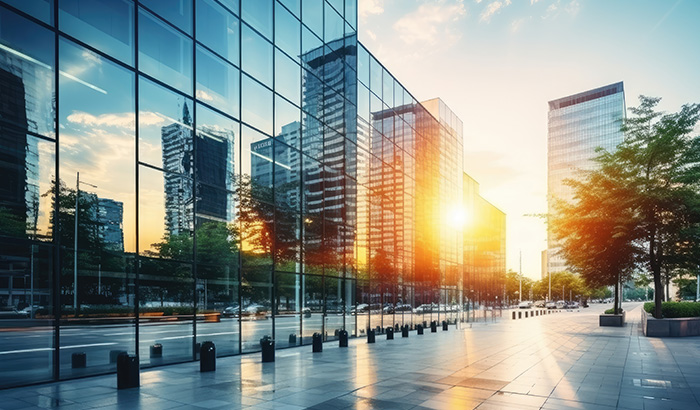
Commercial glass is a key element in contemporary architecture and design. The use of glass in commercial buildings plays a pivotal role in shaping the aesthetic, functionality, and energy efficiency of modern structures.
Whether you’re curious about the different types of glass and their specific uses or simply want to know how thick commercial glass typically is, we’ve got you covered. Our goal is to provide you with insightful, easy-to-understand information that helps demystify the world of commercial glass.
Understanding the thickness of commercial glass
One of the most essential aspects to consider about commercial glass is the thickness of the glass used in various structures. The thickness of commercial glass plays a crucial role in the overall design, safety, and efficiency of a building.
When we talk about the standard thickness of commercial glass, there’s quite a range. It starts as thin as 1/8 inch (3 mm)and can reach up to 3/4 inch (19 mm) or more when the glass needs to bear more weight or withstand higher wind pressures. The selection of thickness is carefully tailored to the specific needs of each project.
Several key factors come into play when deciding on the thickness of commercial glass for any project. The height of the building is a major one, as taller structures face more wind force and thus require sturdier glass.
Safety considerations often call for thicker panes, particularly in high-traffic areas or spaces where the glass is within reach. Sound insulation is another aspect, especially relevant in bustling city environments, where thicker glass can significantly reduce noise levels. Additionally, the quest for energy efficiency can lead to choosing thicker glass for better insulation properties.
To give you a clearer picture, let’s look at some common uses of commercial glass and their typical thicknesses. In storefronts and standard windows, where visibility and strength are needed, glass is often about 1/4 inch (6 mm) thick.
Safety becomes paramount for areas above head height, like skylights, so the glass tends to be thicker — think in the range of 3/8 inch (10 mm) to 1/2 inch (12 mm).
In applications like glass floors and stairs, where the glass must be extremely strong and durable, thicknesses of 3/4 inch (19 mm) or more are common.

Types of commercial glass
Different types of commercial glass offer unique properties and benefits, making them suitable for various applications. Let’s explore some of the most common types of commercial glass and their characteristics.
Tempered glass: tough and safe
Tempered glass is known for its strength and safety features. It’s processed by heat or chemicals to increase its strength compared to normal glass.
If it breaks, tempered glass shatters into small granules instead of sharp shards, reducing the risk of injury. This makes it an ideal choice for areas where safety is a priority, such as doors, shower enclosures, and high-traffic areas in commercial buildings.
Laminated glass: secure and soundproof
Laminated glass is another popular choice in commercial settings, especially for its security and soundproofing properties. It consists of two or more glass layers bonded together with an interlayer, typically made of polyvinyl butyral (PVB). This composition not only makes it harder to break, adding an extra layer of security but also provides excellent sound insulation.
It’s a great option for office buildings in busy urban areas or for storefronts that require additional security.
Tinted and coated glass: energy-efficient and stylish
Tinted and coated glasses are increasingly popular due to their energy efficiency and aesthetic appeal. Tinted glass, available in various colors, reduces glare and heat from sunlight, making it a good choice for lowering cooling costs in a building.
Coated glass, often referred to as low-emissivity or low-E glass, has a microscopically thin metallic coating that reflects heat. This helps maintain a consistent temperature inside the building, reducing energy costs associated with heating and cooling.
Both tinted and coated glasses are widely used in modern office buildings and commercial complexes for their ability to combine functionality with a sleek, contemporary look.
Durability and safety standards in commercial glass
Understanding the aspects of durability and safety standards is critical for any project that includes commercial glass.
Measuring durability in commercial glass
Durability in commercial glass is measured by its ability to withstand various stresses — from environmental factors like wind and temperature changes to physical impacts.
The process involves rigorous testing, including exposure to extreme conditions and assessing resistance to wear and tear over time. This ensures that the glass looks good and can stand up to the everyday challenges it will face in a commercial setting.
Adhering to safety standards and regulations
Safety standards for commercial glass are established to protect the people inside and around buildings. These regulations dictate the minimum requirements for different types of glass in various applications, focusing on aspects like strength, fire resistance, and shatter properties.
Compliance with these standards is crucial; it ensures that the glass used in commercial buildings is not only durable but also safe in case of incidents like breakage or natural disasters.
The importance of compliance in construction and design
Ensuring compliance with these standards during construction and design isn’t just a legal obligation; it’s a moral one. It involves choosing the right type of glass for the specific needs of a project and working closely with certified professionals who understand how to implement these standards effectively.
This compliance is essential for building safety, functionality, and sustainability. It also instills confidence among building owners, occupants, and the public, knowing that the structure meets the highest safety benchmarks.

Energy efficiency and commercial glass
Glass plays a dual role in energy conservation. On the one hand, it allows natural light to reduce the need for artificial lighting. On the other hand, advancements in glass technology help maintain indoor temperature, reducing the reliance on heating and cooling systems.
The strategic use of glass in building design can significantly impact a building’s overall energy footprint, contributing to environmental sustainability and cost savings.
Innovations in energy-efficient glass design
The world of commercial glass is constantly evolving, with innovations aimed at enhancing energy efficiency. We now have options like low-emissivity (low-E) glass, which has a microscopically thin coating that reflects heat.
There’s also thermally insulating glass, which helps keep interiors warm in winter and cool in summer. These technological advancements are changing the game, making buildings more energy-efficient without compromising aesthetics or natural light.
Impact of glass choices on building energy consumption
The type of glass used in a building significantly affects its energy consumption. Choosing the right glass can drastically reduce a building’s energy demand. For instance, double or triple-glazed glass with insulating properties can minimize heat loss, lowering heating costs in colder climates.
Similarly, tinted or reflective glass can decrease the need for air conditioning in warmer regions by reducing solar heat gain. It’s about finding the right balance between letting in light and controlling the internal environment, which, in turn, reflects on a building’s energy bills and environmental footprint.
Maintenance and care of commercial glass
Maintaining commercial glass is key to preserving its appearance and functionality. Proper care not only enhances the aesthetic appeal of your building but also extends the life of the glass.
Let’s explore the best practices and common mistakes to avoid when caring for different commercial glass types.
Best practices for maintaining commercial glass
Regular cleaning is essential. Use a mild detergent and a soft, lint-free cloth or squeegee to avoid scratches. For exterior glass, consider the local climate and environmental factors to determine the frequency of cleaning.
More frequent cleaning may be necessary in areas with more pollution or sea spray. It’s also important to promptly repair any chips or cracks to prevent further damage.
Common cleaning and care mistakes to avoid
Avoid abrasive materials or harsh chemicals that can damage the glass surface. Ammonia-based or vinegar-based cleaners can sometimes react with the glass or the framing, leading to deterioration.
Also, cleaning in direct sunlight can lead to streaking as the cleaning solution dries too quickly. Another mistake is neglecting the frames and seals, which can lead to water leaks or drafts.
Longevity and life cycle of different glass types
The lifespan of commercial glass varies based on the type and quality. Standard glass, with proper maintenance, can last several decades. More specialized types, like low-E or tinted glass, may have different lifespans depending on the quality of the coating and environmental factors. Regular inspections and upkeep are crucial in extending the life of these glasses.
Remember, while glass is durable, its longevity greatly depends on how well it’s maintained and its environmental conditions.

Valley Glass — your commercial glass experts
If you’re on the lookout for expert guidance or quality services for your commercial glass needs, Valley Glass is here to assist. Our experienced team is dedicated to providing top-notch service, ensuring that from selection to maintenance, your glass solutions are handled with utmost care and professionalism.
At Valley Glass, we pride ourselves on not just meeting your expectations but exceeding them, offering the reassurance that your commercial glass is in the best hands.
So, whether you’re embarking on a new project or needing advice on existing installations, contact Valley Glass. Let us help you realize your architectural dreams with our expertise and commitment to excellence.


Leave a Reply